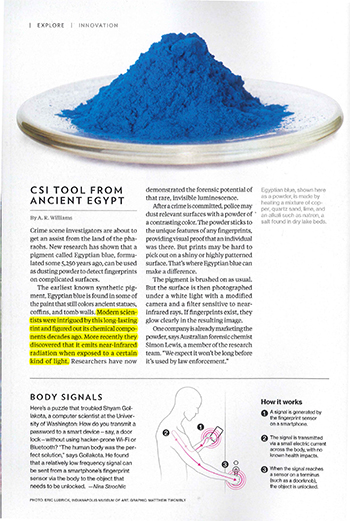 quotes an article “The exceptional near-infrared luminescence properties of cuprorivaite (Egyptianblue)”,
quotes an article “The exceptional near-infrared luminescence properties of cuprorivaite (Egyptianblue)”,
published in 2009 on the scientific magazine Chemical Communications.
Among the authors: Nicola Armaroli (ISOF cnr) and Costanza Miliani (ISTM cnr)
Egyptian Blue, a copper calcium silicate, is a blue pigment rarely found in nature. It was first produced and utilized during the 4th Dynasty of Egypt, around 2500 BC. In 2009, a team of Italian scientists of the CNR (ISOF and ISTM), the University of Perugia and the British Museum discovered that this ancient compound is an outstanding near-infrared (NIR) emitter at 910 nm, upon irradiation with visible light. Its photoluminescence quantum yield is 10.5% and the excited state lifetime is 107 microseconds; these are exceptional values for NIR emission, which make it a promising material for applications in biomedical analysis and photonics. 8 years after this important discovery, a team of researchers in Australia and US have shown that the bright near-infrared luminescence of Egyptian Blue can be easily used for the detection of fingerprints on highly patterned and reflective surfaces, which is much more difficult with existing techniques. This new “CSI” application of Egyptian Blue – based on the 2009 discovery of the Italian researchers – has been highlighted in the May 2017 issue of the National Geographic Magazine, US edition.
“This nice story tells us two important things” – says Nicola Armaroli, of the CNR-ISOF team – “The first one is that only by funding fundamental research we can accomplish technological breakthroughs, the second one is that probably, out there, lots of well-known materials have exciting properties yet to be discovered.”




